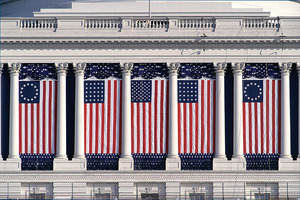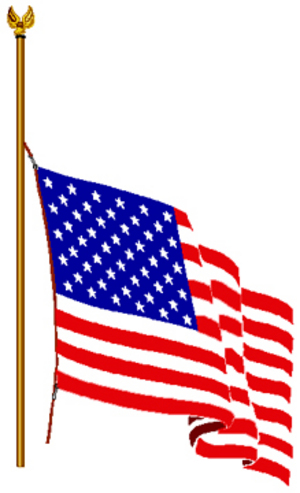The current American flag has been around for over 50 years. The current design became official on July 4, 1960, after Hawaii became the fiftieth state under President Dwight D. Eisenhower. The design of the flag is not set in stone, however. Before 1960 it was constantly evolving, with a new star added for every state. If the U.S. ever adds another state, it will evolve once again.
The earliest American flags
Several flags were flown in New England and by the Continental Navy before 1776. The earliest New England flags contained a “Liberty Tree.” The Continental Navy flew a flag with 13 red and white stripes (representing the 13 colonies), a snake, and the words “Don’t Tread on Me.
The first unofficial American flag being flown at the time of the signing of the Declaration of Independence on July 4, 1776 had 13 red and white stripes with the British “Union Jack” (which is the flag flown in the United Kingdom) in the upper left square (or canton). The Union Jack appears in the flags of several other countries and territories that were former British colonies. The United States took a different route.
The American flag takes shape
On June 14, 1777 (commemorated as Flag Day), the Continental Congress adopted a resolution which stated “Resolved, that the flag of the United States be thirteen stripes, alternate red and white; that the union be thirteen stars, white in a blue field representing a new constellation.” The flag created out of this resolution was the flag being used during the adoption of the United States constitution on September 17, 1787, and when it went into effect on March 4, 1789.
The question of who actually designed the first flag is unknown. An old story states that Betsy Ross sewed the very first American flag. The story of the Betsy Ross flag, with five-pointed stars in a circular pattern, may be a legend. The idea that she created the first flag was suggested by her grandson almost a century after it was supposed to have been sewed.
A more likely story involves Francis Hopkinson. Hopkinson was a signer of the Declaration of Independence, and sent Congress a bill for his design. He was not paid, as he was not the only person to contribute to the design, and already received a salary as a member of Congress. The Hopkinson design had stars in rows, similar to the current American flag, but with six-pointed stars rather than the current five-pointed stars.
The evolving American flag
In 1795, two states had been added to the union in 1791 and 1792, so the flag was updated to have 15 stars and 15 stripes. This was the flag that inspired Francis Scott Key to write what became the American national anthem, known as “The Star-Spangled Banner.” It’s a unique moment in history for the unique 15-striped American flag.
On April 4, 1818, Congress passed a new act stating that the flag would always contain 13 stripes to represent the original 13 colonies, and the number of stars would represent the current number of states. The act made the flag much more practical (just think if the flag had 50 stripes!) while reminding Americans of the founding of the country. The act also stated that new flags would become official on the first Independence Day (July 4) after the admittance of one or more states to the union.
There was no official arrangement for the stars on the flag before the adoption of the 1912 flag with 48 stars. Each time a new flag was adopted many new versions of those flags with stars arranged in various shapes. Although the Army and Navy would use standard designs, some of the more creative designs were beautiful.
Because of the 1818 flag act, the American flag could change once again. Movements supporting statehood for Puerto Rico and other areas could result in new states. If and when new states are added to the union, a new star will officially be added to the flag on the following July 4, Independence Day. Perhaps Americans will even push for another design, rather than having the stars lined up. Such a change would certainly represent the creativity and ingenuity of the American people.






